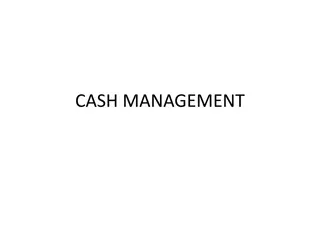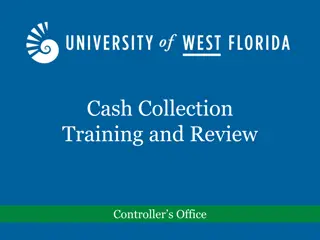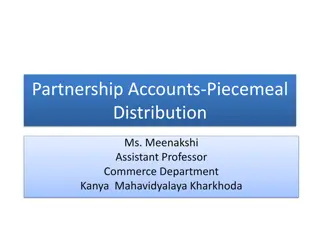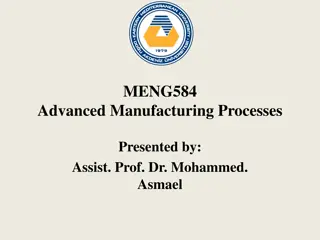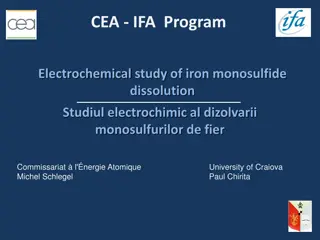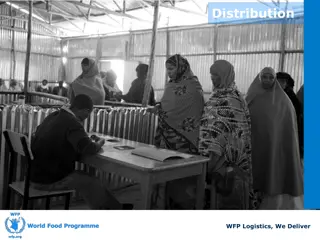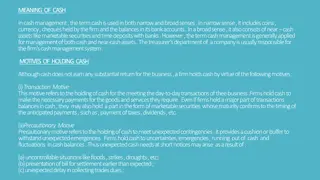Understanding Piecemeal Distribution of Cash in Partnership Dissolution
Piecemeal distribution of cash in partnership dissolution involves systematically distributing cash over stages as assets are realized and liabilities settled. Realization expenses, contingent liabilities, outside liabilities, partners' loans, and partners' capitals are settled in a specific order. If cash is insufficient, payments are made proportionately. Partners' capitals are paid off last, ensuring distribution aligns with profit sharing ratios. The Proportionate Capital Method determines payment distribution based on excess capital and profit sharing ratios.
- Partnership Dissolution
- Piecemeal Distribution
- Assets Realization
- Liability Settlements
- Proportionate Capital Method
Download Presentation

Please find below an Image/Link to download the presentation.
The content on the website is provided AS IS for your information and personal use only. It may not be sold, licensed, or shared on other websites without obtaining consent from the author. Download presentation by click this link. If you encounter any issues during the download, it is possible that the publisher has removed the file from their server.
E N D
Presentation Transcript
PIECEMEAL DISTRIBUTION OF CASH PIECEMEAL DISTRIBUTION OF CASH Piecemeal distribution of cash is concerned with Systematically distribution of cash at the time of dissolution of Partnership. Dissolution of Partnership in it was assumed that the entire dissolution process is completed in a day but it is not the truth, the dissolution of a firm is a lengthy process. The assets are realised in stages or gradually. For example, if partners decide to dissolve a firm on 31st March, the stock may be sold off in April, the debtors may be collected in May and the fixed assets may be sold by July. As and when money is received from sale of assets, it is used to pay liabilities. The liabilities are also paid in stages or gradually. The money, in short, is distributed piecemeal - in stages and not in a single shot. This is known as Piecemeal Distribution.
LIABILITIES SETTLEMENTS LIABILITIES SETTLEMENTS In a piecemeal distribution, the amounts realised from assets are used to settle the liabilities In following order: [1] Realisation expenses [2] Reserve for Unrecorded/Contingent Liabilities [3] Outside liabilities [4] Partners loans [5] Partners capitals. Surplus, if any, arising at the last stage, is distributed to all partners in their profit sharing ratio.
PRO PRO- -RATA PAYMENT RATA PAYMENT If the cash is insufficient to pay off all dues, the payment is made to the concerned creditors (in each category) proportionately i.e. in the ratio of the outstanding balances. PARTNERS LOANS PARTNERS LOANS After all the outside liabilities are paid of the internal liabilities i.e.The partners loans are paid off in the next stage. If the cash is insufficient, payment is made against all partners loans proportionately in the ratio of outstanding balances.
PARTNERS & CAPITALS PARTNERS & CAPITALS After all the outside as well as internal liabilities are paid, the partners capitals are paid off in the last stage. If the cash is sufficient, all the capitals can be paid off. But if the balance is insufficient, payment must be made against all capital accounts pro rata or proportionately. If the capital balances are in the profit sharing ratio, there is no problem at all. The payment is made to all partners in the ratio of their capital balances. But if the capitals are not in the profit sharing ratio, payments at each stage must be done in such a manner that : (a) the payments are in the ratio of the balances of capitals at each stage and (b) the payments ensure that the ultimate profit or loss on realisation is distributed among all the partners in their profit sharing ratio.
PROPORTIONATE CAPITAL METHOD PROPORTIONATE CAPITAL METHOD This method is also known as Surplus Capital Method, Highest Relative Capital Method, Excess Capital Method or Quotient Method. Under this method, first the capitals are compared to the profit sharing ratio. The excess capital (actual capital less capital proportionate to the profit sharing ratio) is paid first. After excess capitals are paid, all capitals are in the profits sharing ratio. Then the payments can be made in the profit sharing ratio. Thus, suppose A and B share profits and losses in the ratio of 2:1 and A capital is 25,000 and B capital is 5,000. The capitals are obviously not proportionate. If B contributes 5,000 for 1/3 share, A should contribute 10,000 for his 2/3 share. Thus A capital is excess to the extent of 25,000 - 10,000 = 15,000. Under the Proportionate Capital Method, first A will be paid 15,000 to bring down his capital to 10,000. Now both the capitals are in the profit sharing ratio. The subsequent payments will then be in the profit sharing ratio.
Illustratin Illustratin Q1 Q1 A, B, C share profits and losses in the proportion of 3:2:1. Their balance sheet is as follows Balance sheet Balance sheet Liabilities Amount Assets Amount Capital Accounts A B C Sundry Assets 80000 30000 30000 20000 80000 80000 The partnership is dissolved and the assets are realised as follows . First Realisation 17000 Second Realisation 21000 Third and Final Realisation 36000 Show distribution of cash at each stage: (a) in profit sharing ratio (b) in ratio of capital Balances.









